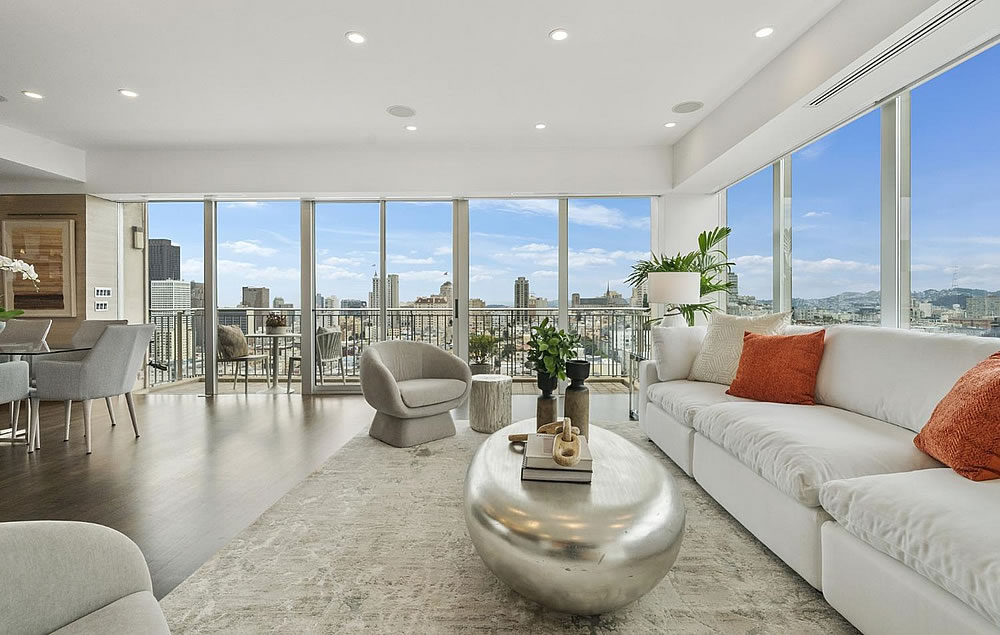Redesigned by Cass Calder Smith in 2002, the 1,462-square-foot, two-bedroom unit #1202 in the Royal Towers at 1750 Taylor Street, “San Francisco’s most distinguished address,” traded for $2.55 million in June of 2015.
Featuring panoramic views, with a modern open concept floor plan, a southern terrace, a designer kitchen with custom cabinetry, and high-end finishes throughout, the southwest corner unit returned to the market priced at $2.795 million in early 2022, was relisted anew for $2.595 million this past June and then reduced to $2.395 million in October.
And having just closed escrow with a contract price of $2.1 million, the resale of 1750 Taylor Street #1202 represents a net 17.6 percent drop in value for the rather distinguished Russian Hill unit, below its 2015 value, on an apples-to-apples basis. And yes, that’s despite the fact that the widely misreported index for “San Francisco” condo values is “still up over 60 percent!” over the same period of time and Russian Hill is a rather established San Francisco neighborhood.






That big aluminum column in the middle of the place is very “interesting”.
B-b-but that’s not the real San Francisco!
>$1,400 psf isn’t exactly skid row, either. OP doesn’t mention the HOA charge but that must be substantial.
If it was me, I would probably close-off the kitchen and wrap that metal column with sheetrock for more space to display artwork.
The HOA fees for unit 1202 are $2,215 which I agree is substantial, but not unreasonable for a building in this neighborhood with a 24 hour doorman, pool, elevator and grounds maintenance involved.
On a per ft.² basis, another seller is asking a mere 81 percent more than the closing price of unit 1202 for a unit on a lower floor (Unit 1703) that just went on the market earlier this month. Let’s see how that works out for them.
Long story short, it has pano views of city lights at night, and any property will sell if its priced correctly.
Also, the reported decline is not exactly apples-to-apples as the cost of the 2022 redesign is not reflected.
It’s apples-to-apples versus 2015 as the redesign was in 2002, not 2022, as outlined above.
USGS scientists have found evidence for 12 quakes on the southern Hayward Fault during the past 1,900 years. Notably, the last six quakes (in 1134, 1317, 1475, 1629, 1725, and 1868) occurred at intervals of 95 to 183 years, with an average interval of about 150 years. The 150th anniversary of the 1868 quake was in 2018; scientists are convinced that the Hayward Fault has reached the point where a powerful, damaging earthquake can be expected at any time.
Older concrete buildings, when they get damaged, can lose their vertical load-bearing capacity and collapse. San Francisco got a reminder of the danger from a series of earthquakes in Turkey and Syria. More than 50,000 people died in those earthquakes, many of them in collapsed or damaged buildings with insufficiently reinforced concrete. Concrete buildings in the U.S. received attention in 2021 after the collapse of a condo tower in Surfside, Florida, but the problem in San Francisco and other earthquake-prone areas is different. Rather than delayed maintenance, it’s about the design of the structures and how they’d fare under intense shaking.
It’s obvious you aren’t comfortable living here… long time residents like me don’t worry about the “big one”. Move on.
There are differences between being (1) aware and cautious of risks or (2) blithely unmindful and “comfortable”. Since my guess is you do not personally have a recent seismic report for 1750 Taylor Street that eliminates #1. However, should that assumption be wrong, please share the name of the seismic engineer, the date the building’s seismic report was prepared and its stated SUL (Scenario Upper Loss)?
This information will enable everyone to make an informed decision about the actual situation. In the meantime, the rest of us can relax in low-rise, braced wood-framed buildings constructed on non-fill-land when the inevitable tectonic time-bomb hits.
The level of concern depends on many factors including where you live. Fact is the Big One is coming, we just don’t know when. Could be tomorrow. Could be 2063. If you live in a seismically sound building and are prepared for a week or two without power, phone, or water then your worries are smaller. But don’t expect no impact. The whole area’s economy might be on pause for months during the recovery.
This building is new enough that it is likely to stay structurally sound for residents to safely evacuate. But like most high rise buildings, it might be too damaged to re-occupy. Hope for the best but plan for a total loss.
I’m bay born and raised, and I do actually worry about “the big one” in that I keep my emergency supplies up to date, have a designated out of state contact, and a reunification plan with the family. I am not a fan of high rises, but that has far more to do with liking yard space and not living HOA fees, but I also think (at least briefly) about evacuations routes and building stability when I’m in any tall building, be it for fire or earthquake.
I think it’s rude and presumptuous to assume that being concerned about earthquake safety is something only a transplant would do. Any sensible person should consider and prepare for the local flavor of natural disaster. Everyone’s risk evaluation is different, and just because you are indifferent doesn’t mean it’s a mark against someone to be nervous.